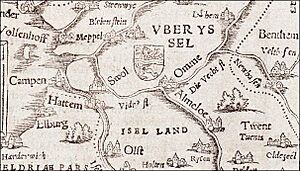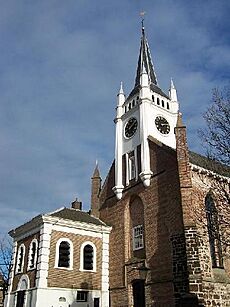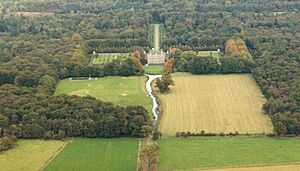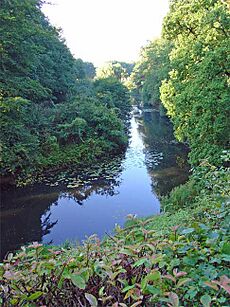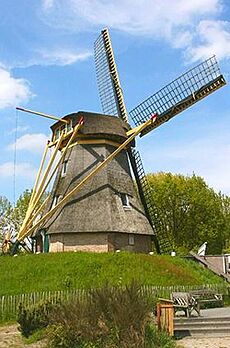Ommen facts for kids
Quick facts for kids
Ommen
|
|||
|---|---|---|---|
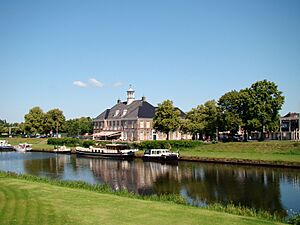
Ommen's old town hall, the river Vecht, and the city centre in the background.
|
|||
|
|||
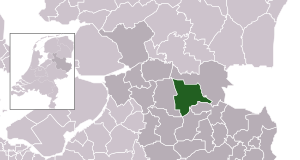
Location in Overijssel
|
|||
| Country | Netherlands | ||
| Province | Overijssel | ||
| Government | |||
| • Body | Municipal council | ||
| Area | |||
| • Total | 182.01 km2 (70.27 sq mi) | ||
| • Land | 180.00 km2 (69.50 sq mi) | ||
| • Water | 2.01 km2 (0.78 sq mi) | ||
| Elevation | 6 m (20 ft) | ||
| Population
(May 2014)
|
|||
| • Total | 17,333 | ||
| • Density | 96/km2 (250/sq mi) | ||
| Demonym(s) | Ommenaar, Ommer | ||
| Time zone | UTC+1 (CET) | ||
| • Summer (DST) | UTC+2 (CEST) | ||
| Postcode |
7685, 7730–7739, 8145–8149
|
||
| Area code | 0523, 0529, 0572 | ||
Ommen is a town and municipality in the eastern Netherlands. It's located in the Vecht river valley in the Overijssel province. Ommen was first mentioned in the early 12th century. It officially became a city in 1248. The municipality had a population of about 17,333 people in 2014. It covers an area of 182.01 km2 (70.27 sq mi).
Contents
Discover Ommen's Communities
Besides the main city of Ommen (with about 8,710 people) and the town of Lemele (with about 570 people), the Ommen municipality includes many smaller villages and hamlets.
- Archem
- Arriën
- Arriërveld
- Beerze
- Beerzerveld
- Besthmen
- Eerde
- Giethmen
- Junne
- Ommerschans
- Stegeren
- Stegerveld
- Varsen
- Vilsteren
- Vinkenbuurt
- Witharen
- Zeesse
Ommen's Long History
How Ommen Began
The first people in the Ommen area were probably hunter-gatherers. They moved around a lot. Tools made of flint from about 9,000 BCE show that people were here. But they didn't farm or live in one place permanently back then.
The Vecht and Regge rivers were very important. Most of the Salland region was marshy. But the higher riverbanks had good soil for agriculture. Rivers were also key for trade and travel. The first farms appeared along these rivers around 5,000 BCE. All early settlements in Ommen were built near rivers. Only Lemele was on a hill, safe from floods.
Ommen itself was a great spot for a settlement. It had fertile soil and higher ground. There was also a place to cross the Vecht river. This helped trade routes between the north and south. Archeologists think the first settlement in Ommen started in the 8th century CE. By the late 11th century, it was a proper town. The first settlers were farmers who also traded and ran inns. A church was built around 1150. It was soon replaced by a stone church, showing the town was growing. Ommen was first mentioned in writing in 1133.
Many different powers influenced the area. The Prince-Bishop of Utrecht wanted to control everything. Nearby cities like Zwolle also had influence. Local farming groups had their own rules. Also, castles were built by powerful local leaders. These leaders sometimes charged tolls on river trade. This made it hard for Ommen to grow. But one of these leaders actually helped Ommen become a city.
Becoming a City
On August 25, 1248, Ommen was given city rights. This meant it could build walls for protection. This happened after a local leader, Rudolf of Coevorden, attacked the town twice. Ommen was important to the Bishop of Utrecht. It was a good place to defend his land against rebellious groups. Ommen became the 4th oldest official city in Overijssel.
A wall was built around Ommen with three gates. The bells in the church tower still ring every evening at nine o'clock. This tradition comes from when the city gates used to close. Ommen never got a moat, even though it was allowed one.
Ommen soon became a busy port and market for farm products. It joined the Hanseatic League, a group of trading cities. Most of its trade was with other Hanseatic cities like Zwolle and Deventer. A toll bridge over the Vecht river, first built in 1492, made Ommen even richer. People had to pay to cross the bridge until 1925.
For centuries, important meetings for the Oversticht region happened near Ommen. But conflicts between cities grew. In 1519, citizens from Zwolle attacked a meeting and looted nearby Eerde castle. This led to more fighting in Overijssel.
Times of Trouble
In 1522, soldiers from Guelders helped citizens of Zwolle attack Ommen. Only the church and a women's home survived the fire. Ommen was part of Guelders until 1528. Then, Emperor Charles V took control. A new city hall was built in 1531. In 1568, Spanish troops attacked Ommen again. This time, the church and city hall were saved. In 1581, Dutch leaders met near Ommen to declare independence from Spain.
The 17th century was tough for Ommen. A big fire in 1624 badly damaged the church. To control traffic and stop invasions, the Ommerschans fort was built. In 1672, another huge fire destroyed almost all of Ommen, except the church. That same year, called the 'Disaster Year', a war broke out. Foreign troops often marched through Ommen, demanding food and lodging. It took until 1753 for Ommen to recover enough to build a new city hall.
People in Ommen also became unhappy with their leaders. In 1732, citizens protested against the city council. Riots happened, but order was restored. Unrest continued until the Batavian Revolution in 1795.
Ommen in Modern Times
In 1809, the mayor of Ommen prepared for a visit from King Lodewijk Napoleon. But the king had already passed by! The mayors quickly caught up and still received a gift.
When Napoleon Bonaparte took over the Netherlands in 1810, he changed local governments. Ommen's separate areas were combined. This made many people unhappy. After the Netherlands became independent again in 1818, Ommen was split into two municipalities: Stad Ommen and Ambt Ommen. They shared one mayor from 1851.
In 1819, there were plans to turn Ommen into a fortified city. But these plans were never carried out. The IJssel river to the west was seen as a better defense line.
The old toll house by the bridge was replaced by a new city hall in 1827. This building housed all city offices. The city hall was used until 1982. Now, it's a museum and a restaurant.
In 1923, Stad Ommen and Ambt Ommen were combined again. The borders of the municipality have stayed mostly the same since.
On February 6, 1972, a group called Black September tried to blow up a natural gas pipeline near Ommen. Not all the explosives went off. A blue bag with explosives was found. There was also a large crater. Similar attacks happened in other places that night.
Eerde Castle and its History
About four kilometers south-east of Ommen is Eerde Castle. It's a beautiful castle from 1715. It's surrounded by a large estate with a Baroque style garden. The Natuurmonumenten foundation manages this area.
The name "Eerde" means "earth" in an old language. The first castle here was built in the 14th century. It was destroyed in 1380. Over the centuries, different noble families lived in castles on this site. The famous philosopher Jiddu Krishnamurti used the castle from about 1924. He held his lectures here for thousands of people.
During World War II, a camp called Kamp Erika was located near Eerde. It was mainly for Dutch people who broke rules or resisted the occupation. The camp was known for its harsh conditions. It was liberated on April 11, 1945. After the war, it was used to hold Dutch people who had helped the German occupiers.
Today, Eerde Castle is home to an international boarding school. It offers the IB program.
Ommerschans Fort and Labor Camp
About ten kilometers north of Ommen is the former Ommerschans fort. It was built in 1628 to defend the northern provinces from attacks. The fort was strengthened in the mid-17th century. But in 1672, it was captured without a fight during a war. The soldiers stationed there fled. They returned later when the attackers retreated.
The fort was closed in 1715. But it was reopened in 1740 when war started again in Europe. In 1787, militias from other cities attacked Ommerschans. They stole all its weapons. The fort was then abandoned and never used for military purposes again.
In the early 1800s, the Dutch government turned Ommerschans into a place for people who were struggling. It was a labor camp where people were supposed to learn farming and good habits. But in reality, people were forced to work for very little pay. They reclaimed wetlands around the fort. A writer named Jacob van Lennep visited in 1823. He was shocked by the conditions there.
The institution went bankrupt in 1859. The government ran the camp until 1889, when it finally closed. Thousands of workers lived there over the years. Sadly, many died while interned.
Life in the City of Ommen
Location and What People Do There
Ommen is about 20 kilometers east of Zwolle, the provincial capital. It's also about 35 kilometers north-east of the old Hanseatic city of Deventer. Ommen is on the north bank of the Vecht river. The Regge river joins the Vecht nearby. Only small boats can use these rivers.
Ommen is a rural area. So, tourism and agriculture are very important for its economy. The forests and hills around Ommen attract many visitors who love nature. The city has hotels and many campgrounds. Gilwell Ada's Hoeve was the first Scouting campground in the Netherlands. Ommen also has a small marina.
Ommen has a train station that opened in 1903. It's about one kilometer from the city center. Trains stop there about twice an hour. Ommen used to have more train lines, but they were closed when cars became popular.
A big road, the N34, crosses through Ommen. It goes from Zwolle to Groningen. A main crossing near the Vecht bridge often causes traffic jams. The government is building a new route for the N34 north of the city to reduce traffic.
Ommen's International Connections
Ommen is connected to other towns around the world. This is called "twinning" or "sister cities."
|
|
Ommen's Culture
The Bissing Fair
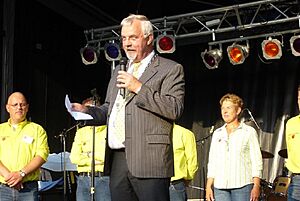
Ommen is famous for its yearly Bissing fair and markets. These markets have been held on the second Tuesday of July since at least 1557. In the 19th century, it was one of the biggest markets in Overijssel. There were often fights and riots. In 1918, the church asked the town council to stop the public events around the Bissing. The council agreed, and activities were stopped until 1958. The market itself continued.
Today, the Bissing is a major tourist attraction. It lasts for five Wednesdays after the first market day. It includes many ceremonies, concerts, funfairs, and activities.
The word Bissing might come from "Bishop's day." This would recognize when Ommen got its city rights. Others think it's related to the English word "business."
Local Language
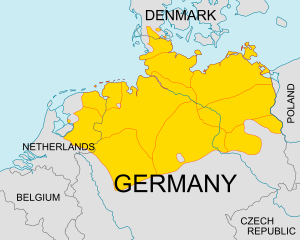
Most people in Ommen speak Dutch. But many also speak Low Saxon or Plat. This is an old language related to Low German and Old English. It's spoken in the north-east of the Netherlands. The dialect spoken in Ommen is Sallands. Both the Dutch government and the European Union recognize Plat as a regional language. But its popularity is decreasing.
The poet Johanna van Buren lived in Ommen. She wrote poetry in the Salland and Twents dialects. Her work is still popular. The Johanna van Buren Cultural Prize is given every three years to someone who helps regional culture.
Religious Life
Ommen has different Christian churches. There are Roman Catholic, Dutch Protestant, and Liberated Reformed churches.
Ommen was built around its old church. It was built around 1150. The church became Calvinist during the Reformation. It wasn't until 1853 that Roman Catholicism was openly practiced again. A new Roman Catholic church was built in 1860. The village of Vilsteren, west of Ommen, has remained mostly Roman Catholic for centuries.
The famous preacher Albertus van Raalte lived in Ommen from 1839 to 1844. He later moved to America. There, he helped found a church and the city of Holland, Michigan.
Jewish people in the Ommen area were often butchers. Most of Ommen's Jewish community was killed during the Holocaust. Others left after the Nazi occupation of the Netherlands. The synagogue building was torn down in 1956. Jewish graveyards still exist.
Places to See in Ommen
- The church in the center is the oldest building in Ommen. It was built in 1150 but has been rebuilt and renovated many times.
- The National Tin Figurine Museum is in the old Town Hall. It has over 200,000 figurines and displays.
- Ommen has five windmills. Three are in the town itself: the Lelie (1846), Den Oordt (1842), and the Konijnenbelt (1806). Vilsteren and Besthem also have windmills. The Besthemermolen also has a Nature Information Centre. It shows exhibits about Ommen's varied landscape and ecosystems.
- The small Regional Museum in Ommen explains the town's customs and history.
- The estates of the Vilsteren and Eerde castles are open to the public.
- The Pieterpad walking trail, which is very popular, passes through Ommen.
Famous People from Ommen
- Albertus van Raalte (1811–1876): A preacher who founded Holland, Michigan in the USA.
- Dirk Van Raalte (1844–1901): An American soldier and politician.
- August van Groeningen (1866–1894): A writer.
- Johanna van Buren (1881–1981): A poet.
- Gerrit Bouwhuis (1888–1957): A Dutch sports shooter who competed in the 1924 Summer Olympics.
- Philip baron van Pallandt (1889–1979): A pioneer of Dutch Scouting.
- J. H. A. Lokin (born 1945): A jurist and academic.
- Edward Top (born 1972): A composer.
- Malik Azmani (born 1976): A Dutch politician and Member of the European Parliament.
See also
 In Spanish: Ommen para niños
In Spanish: Ommen para niños




